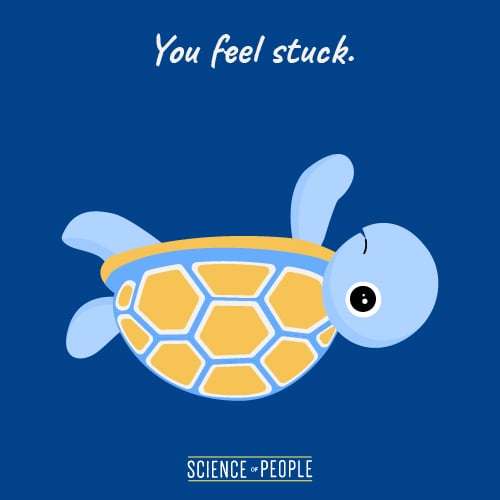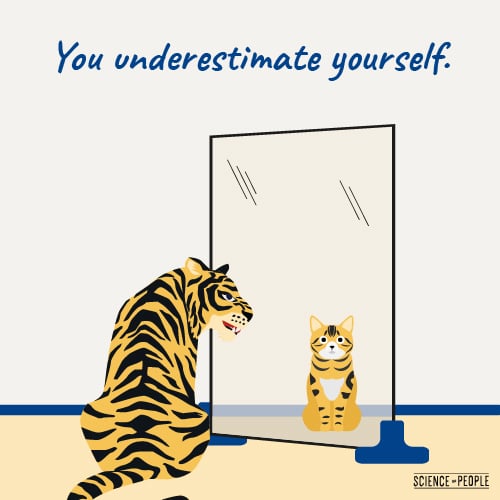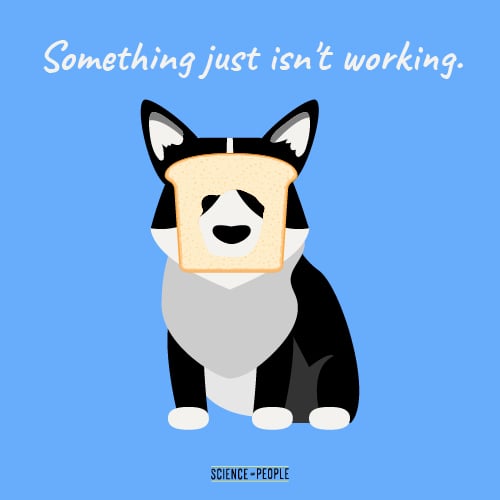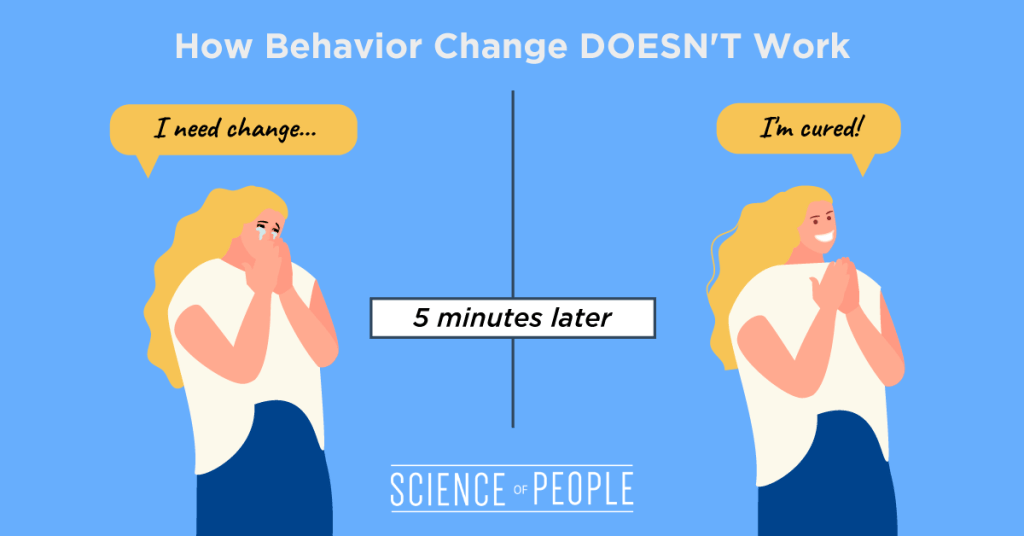Here’s a shocking fact: 69% of people feel trapped in the same routine, and only 3 out of 10 people are happy with their lives.
So if you’re looking for:
- a change in your behavior
- a new job/body/environment
- a new sense of purpose
then I’ve got the actionable tips you need in this ultimate guide to change.
I was inspired to write this article after an amazing interview I did with Professor Katy Milkman, author of the new book How to Change.
In the video, we go over the essential things to know before making big changes in life:
How to Know When You NEED a Change
How do you know if you need a reset? A change? Something new?
It’s quite simple:
There are 3 main reasons why people feel the need to change.
Once you identify your reason, move on to the actionable tips below.
You Feel Stuck

If you’re feeling stuck, you might be undergoing a “psychological impasse.”
A psychological impasse is when you feel trapped or emotionally attached to where you are in life.
In other words, you want to change, but you feel like you can’t.
For example, let’s say you work a 9–5 office job. You want to be free but feel obligated to stay for the paycheck.
You Underestimate Yourself

Another reason to change is because you constantly feel underestimated or that you are not hitting your potential:
- others undermine your potential
- you feel held back
- you’re afraid of making mistakes
- you have a big fear of failure
- you underestimate yourself
- you feel you have more to give, more to earn, more to win, more to do
Nobody wants to feel underestimated or over-limited.
Something Just Isn’t Working

Maybe you’ve tried everything.
You’ve done your research, said you’ll change, but you’re back where you started. You’re still the same.
Have you had the same goals 3 years in a row? 5 years in a row? You are not alone.
Of those who made New Year’s resolutions in 2020, only 35% managed to keep them.
So what gives? Clearly something just isn’t working.
8 Ways You Can Change
In this section, I’m going to show you the BEST actionable tips you’ll need to change.
So if you want to:
- increase your productivity
- change yourself mentally
- take control of your diet
- transform your lifestyle
- get a sense of purpose
then these tips will help you get there.
Pick a Fresh Start
Pick a meaningful date to change. It could be:
- your birthday
- your anniversary
- the beginning of summer
- the beginning of the week
Got that date in mind? Cool.
Research shows that starting fresh is one of the best ways to get a headstart on your goals. We have the most motivation at the start of something new. This is called the Fresh Start Effect.
The Fresh Start Effect is when we use timing landmarks to help kickstart our goals.
The researchers found that Google searches for terms like “diet,” gym visits, and commitments to pursue goals are all highest at the start of the week, month, year, or semester. This also happens on birthdays and holidays. Fresh starts create landmarks that help people put their old ways behind them and start fresh with better behavior. This “mental accounting” allows people to relegate past imperfections to a previous period and induces people to take a big-picture view of their lives. This is the best way to motivate aspirational behaviors.
You should ALWAYS be using the Fresh Start Effect with your goals.
I want you to create a calendar event and schedule in your fresh start. Now marks the time to change. Set a calendar alert for your fresh start every month to check up on your progress.
If you’re feeling up for it, set 5 new fresh starts one month apart NOW to keep the momentum going. Set an alert to start new goals on:
- your birthday
- New Year’s
- the start of each month
- the start of each season
Make it Easy
Making your goals easy to accomplish is key.
The big mistake people make with goals is they start too big and too hard. If you want to eat healthier, it’s hard to say you will not eat bread or stop eating out. That’s a HUGE behavior change. But starting small with “I want to eat more fruit” is easier. And even easier than that is…
- arranging fresh fruit bowls around the house while burying the chips inside the cabinet
- leaving your keys and running shoes next to your bed so you’re ready to go in the morning
- leaving your phone charger next to your office desk so you don’t bring it to the bedroom
The Big Takeaway: Whatever you want to accomplish, leverage your lazy. Make accomplishing your goals as easy as possible so you’re more likely to do them. Know your traps and avoid them.
Join a Community
What do Tough Mudder, Alcoholics Anonymous, and Weight Watchers all have in common?
There is a HUGE community behind these groups. According to Dr. Sean Young in his book Stick With It, communities are great for behavior change because they fulfill our desires:
- Trust: We want to trust others and see that our goals are possible, and joining a fitting community is the solution.
- Bonding: Having like-minded people to surround yourself with helps you bond and even make friends.
- Self-Worth: Being with others helps keep each other motivated and feel accomplished.
- Accountability: Being with others, just like a mastermind, adds accountability.
- Reward: Being around others who share a similar goal is rewarding in itself.
- Control: With a group, you naturally feel more in control than going it alone.
The Big Takeaway: Having a community boosts your chances of actually hitting your goals. Try Meetup.com, Facebook Groups, or join a hobby group like running triathlons or going vegan to find like-minded people.
Acknowledge Your Stage
To find out how change happens, researchers James Prochaska and Carlo DiClemente studied how people change and came up with the Stages of Change model.
The Stages of Change model suggests that at the beginning, change is hard. There will be struggle, denial, and even relapse. But as you progress, things get easier. You’re more committed to change and have developed good habits at this point.
There are 5 stages to this model, and recognizing where you are in this cycle is the first part of the change process:
- Stage 1: Precontemplation. At the beginning stage, you might not see a problem. Or if there is one, you deny it. For example, a serial procrastinator might say, “Oh, I’m just an hour late!” and continue to procrastinate. You may even feel like you’re not in control to change.
- Stage 2: Contemplation. The next step, you realize there’s a problem. You’re always late, and it’s taking a toll on your life. You may want to change but haven’t taken action yet. Some people never leave this stage and remain contemplating for months or years.
- Stage 3: Preparation. This stage, you start to research. This includes reading books, going to seminars, or asking friends and family for advice. According to Prochaska, 50% of people who skip this stage will relapse within 21 days.
- Stage 4: Action. Finally, action is taken. For this step to be successful, enough preparation has to be done beforehand to outline the right action to take. For example, the serial procrastinator might make a plan by setting an alarm on their phone and treating themself to a reward every time they show up on time.
- Stage 5: Maintenance. After new habits are built, this stage is important to keep those good habits—and avoid falling back to the bad ones. Rewarding yourself is key to this phase. Bad habits can come back with a vengeance—so this stage can last for months to solidify permanent habits.
The Big Takeaway: Recognize what stage you are at right now. Make time for each stage, and don’t skip any or you might risk relapsing sooner.
Set Your Goals
Research shows that goal setting works. It helps:
- professors get tenure faster
- employees get larger raises
- students learn up to 250 percent faster
But the question is:
How do you effectively go about setting and achieving your goals? Try taking your Emotional Temperature.
In essence, the technique goes like this: on a piece of paper or on our downloadable goal setting worksheet, rate these areas of your life on a scale from 1 to 5 (1 being extremely dissatisfied, 5 being extremely satisfied).
- Business: How do you feel about your work, career, or business effectiveness and success?
- Friends: How is your social life? Your friendships and support system?
- Family: How are your personal relationships? Your partner or spouse?
- Personal Passions: Do you have personal passion projects, hobbies, or fun activities that fulfill you?
- Spiritual: You can interpret this one any way you like. It could be your faith, mental health, personal journeys, or mindset.
- Health: Are you happy with your physical health and wellness?
I call this your Goal Wheel.
The Big Takeaway: Know your goals. When you have your goals down, feel free to check out how to set your goals.
Have Accountability
Making goals is easier than sticking with them, so get help!
This is where accountability comes into play. Grab a friend, tell your parents, or use a website like Stickk to hold you accountable.
Even better, put your money on the line if you fail to take action.
For example, if you set an alarm to get up at 6 a.m. for a 30-minute run, but you roll over in bed and go back to sleep, keep yourself accountable and donate money to your favorite charity. Or have your partner pull off your blankets—horrible, but it does work for me! = )
The Big Takeaway: Accountability will help you change and accomplish your good habits, one by one.
Pro Tip: Since studies show that people are highly risk-averse, try setting your accountability donation to a charity you dislike. This is called an anti-charity. You might be even more motivated not to miss your goal!
Exercise Change
If you’re feeling really stuck, try changing lots of little things to kickstart yourself:
- set your alarm at a different time
- take a cold shower
- drink half-decaf instead of full-strength coffee
- try incorporating a “Meatless Monday” into your week
- delete 3 random apps on your phone that take up your time
- go on a digital detox
- listen to a new genre of music
- switch up the furniture in your house
- try volunteering
The Big Takeaway: Introduce change into your routine. It doesn’t have to relate to your goals. Any bit of change can really open yourself up to other possibilities.
Change Your Mental Scripts
How do you mentally talk to yourself?
- calmly and rationally
- negatively and harshly
- positively and warmly
If you answered C, you’re in a great spot!
Self-talk is everything. And when it comes to change, how you talk to yourself may be more important than what you do.
Here’s what I mean:
A remarkable 2013 study observed anorexic women as they walked through doorways. Scientists noticed that the women actually turned their shoulders at an angle when entering the room—even when there was plenty of space for them to fit through the door!
The question is: How do you see yourself?
The way we talk to ourselves is the way we think about ourselves.
If you constantly tell yourself:
- “I’m no good.”
- “I’m so lazy.”
- “I’m not good enough.”
- “I can’t change.”
then you’re limiting how well you CAN change.
The Big Takeaway: Change your mental self-talk. If you’re having trouble, I highly recommend incorporating positive affirmations in your routine. Write them on a note that you can carry with you. Put it in your wallet, hang it as a car mirror accessory, or put it on the back of your phone case. Check out our list of 120 Positive Daily Affirmations For Happiness for more.
Captivating Rewards
You need to be rewarded for accomplishing your goals, right?
But not just ANY old reward.
Dr. Young mentions “captivating rewards” as the best type of rewards to give yourself. These rewards are extremely powerful and meaningful, and are typically not financial.
How do you give yourself captivating rewards? Try the following:
- Incorporate fun. If an activity is fun, you’ll find it intrinsically rewarding. This can mean remote working at a cafe or exercising with groovy music on. Sometimes I reward myself with new treats like a special kind of green tea that I’ve been saving.
- Don’t use money all the time. Financial incentives don’t usually work, and if they do, it’s only up to a certain point.
- Gamify. Try using one of the many goal tracking apps out there, or journal your own goals and see your progress visually “level up.”
The Big Takeaway: Your rewards need to be emotionally powerful. They should be something you really look forward to and that makes you happy.
5 Ways NOT To Change
In this section, I’m going to cover five BAD ways we try to change. I call these “change traps”!
Things like:
- trying to change too fast
- procrastinating
- sticking to our identities
After reading this, you might be surprised at what’s keeping you back.
Change Trap #1: Overly Big Goals
Want to know one of the biggest mistakes I see people make?
Look at this person:

Of course, this is unrealistic. Change is a natural process and takes time. But often, we want to accomplish big things way too fast.
According to a 2009 study, a habit takes anywhere from 18 to 254 days to form.
Let me repeat: 18 to 254 days.
So if you’re looking for a quick fix, it might be impossible. And if you’re setting big, lofty goals, you might want to tune them down.
The Big Takeaway: Slow and steady wins the race.
Change Trap #2: Information Overload
Some people try to change by consuming too much:
- reading too many books
- taking too many courses
- overthinking
I’m guilty of this. But overconsumption is procrastination in disguise. We consume more because it’s “good for us” or we think we don’t know enough.
But true change comes from action.
Here’s what you need to do, using the Stop, Drop, and Control technique:
- Stop what you’re doing. Realize how much research you’ve put in. If you’ve been at it for days, then chances are you’re already prepared.
- Drop the learning. Even if you’re in the middle of another self-help book, it’s time to drop it.
- Control your life. Take the appropriate action that you’ve learned.
The Big Takeaway: Once you realize action > overconsumption, you’ll be ahead of the game.
Change Trap #3: Being a Conformist
In 1951, researcher Solomon Asch conducted an experiment in which 50 male students from Swarthmore College in the USA participated in a test.
The test was simple: look at the line on the left and match it to the similar line on the right:

It’s pretty obvious that line #1 is the correct line, right?
Here’s where it gets interesting:
For the test, each participant was placed in a room filled with 7 “insiders”—these insiders were tasked with giving the researcher the same incorrect answer.
And when it was finally the participant’s turn, about ⅓ of the time they would conform with the group!
The Big Takeaway: If you want change, this often means being the odd man out.
Check out the experiment below from Netflix’s Explained:
Change trap #4: But it’s FREE!
Have you ever fallen victim to the “free” fallacy?
- free books
- free trials
- free seminars
When seeking help, “free” can be misleading.
For example, if you’ve ever received a “free day pass” email to go to the gym, you might have been excited… until you actually arrived. Then you realized that one hour spent signing documents and listening to their personal trainer pitch might have been better spent elsewhere.
The Big Takeaway: Be careful when offered a quick fix for free. Good things may cost money. But the opposite is also true—expensive education may not be worth it.
Change Trap #5: Associating Identities
If you’re trying to quit a nasty habit, you must NOT cling to your identity.
For example, if you’re trying to kick a bad habit like procrastination or binge eating, you have to stop thinking of yourself as a smoker or binge eater.
What can be even more hurtful than bad habits is a bad identity.
You see, we all want to belong. But sometimes, our identities can literally prevent us from blossoming into who we want to become.
The Big Takeaway: I want you to think differently.
Instead of “I’m a procrastinator,” think, “I have procrastinated.”
YOU are not the action, but you have performed the action. Once you get this to stick, you’ll feel freer to break that action.
Bonus: How to Change Your Productivity
If you’re a serial procrastinator or lacking in mental sharpness, this section is for you.
You see, great productivity requires a great method.
But not just any method.
Choose the productivity method that works for you.
Easier said than done, right? With so many productivity methods to choose from, I’ve gathered my top 3 I use throughout my work day.
These methods keep me mentally sharp and ready to take on whatever task I have:
- The 30-Minute Rule. If you’re a fan of creating daily tasks, then you know how tedious it might be to complete them (especially the really long ones). Here’s an easier way. The 30-minute rule makes my tasks more achievable. In a nutshell, I try to set my tasks so they take no more than 30 minutes. So instead of “Finish recording YouTube video,” I might break it down to “Finish YouTube script,” “Record video,” etc. This helps TREMENDOUSLY to make tasks more digestible.
- The GTD Method. GTD, short for Getting Things Done, was created by productivity master David Allen and is for the serial overthinkers and people with too many projects. The basic concept is simple: since we’re constantly thinking, we need to get rid of that “junk” clouding our judgment. So what should we do? This method has 5 steps and takes a little bit of up-front time investment. But it’s so, so worth it to have everything organized. Read more about this method here.
- The Pomodoro Technique. Studies show that frequent breaks “reset” your mental sharpness. So if you’re a fan of time blocking, you’ll love this technique. Using the Pomodoro Technique, you’ll work anywhere from 25 minutes to an hour and take a 5- to 15-minute break in between. I love this method because I always feel refreshed to tackle my work after my break is over. I highly recommend trying out an app to start this technique, such as Be Focused or Pomofocus.
The Big Takeaway: Pick a technique above. If it works, stick to it consistently. I also have a list of other productivity hacks you can try out. Test them out and ditch the ones that don’t work.
If this post helped you, feel free to comment below what things in your life needed change.
In the end, I want you to be courageous. I want you to face your fears.
And I KNOW you can do this!

Great curation of a wide variety of information presented with some new twists. Well done and a great read.
Great curation of a wide variety of information presented with some new twists. Well done and a great read.
Great curation of a wide variety of information presented with some new twists. Well done and a great read.
This was a great read, and powerful reminder that we are in control of our lives. I love how all of your tips are things “I” can do. I can change this, I can do this, I can learn to do this, etc. I can control my situation, one step at a time. –Ryan
This was a great read, and powerful reminder that we are in control of our lives. I love how all of your tips are things “I” can do. I can change this, I can do this, I can learn to do this, etc. I can control my situation, one step at a time. –Ryan
This was a great read, and powerful reminder that we are in control of our lives. I love how all of your tips are things “I” can do. I can change this, I can do this, I can learn to do this, etc. I can control my situation, one step at a time. –Ryan
I find that having a spiritual life is very important and keeps me grounded. Praying every day; reading scripture passages and listening to music and having simple workouts to keep mind and body together. You need to have inputs into your life that make a difference and make you think differently. Keep your mind active and keep learning is essential.
I find that having a spiritual life is very important and keeps me grounded. Praying every day; reading scripture passages and listening to music and having simple workouts to keep mind and body together. You need to have inputs into your life that make a difference and make you think differently. Keep your mind active and keep learning is essential.
I find that having a spiritual life is very important and keeps me grounded. Praying every day; reading scripture passages and listening to music and having simple workouts to keep mind and body together. You need to have inputs into your life that make a difference and make you think differently. Keep your mind active and keep learning is essential.
Excellent insights, the tips are doable and GTD method is something new for me, will definitely read the book written by David Allen… thanks for the inspiring article on procrastination
Excellent insights, the tips are doable and GTD method is something new for me, will definitely read the book written by David Allen… thanks for the inspiring article on procrastination
Excellent insights, the tips are doable and GTD method is something new for me, will definitely read the book written by David Allen… thanks for the inspiring article on procrastination
This was a powerful reading for me, I have been following Vanessa for about two years, and I have no regrets, All her advises are great
This was a powerful reading for me, I have been following Vanessa for about two years, and I have no regrets, All her advises are great
This was a powerful reading for me, I have been following Vanessa for about two years, and I have no regrets, All her advises are great
My biggest takeaways are having accountability, emotional rewards, and taking small breaks. Thanks for sharing Vanessa.
My biggest takeaways are having accountability, emotional rewards, and taking small breaks. Thanks for sharing Vanessa.
My biggest takeaways are having accountability, emotional rewards, and taking small breaks. Thanks for sharing Vanessa.
Yes, small steps. I can do this. Vanessa, do you have a BLOG on how to stay motivated, once I start? Yes, I read about accountability and groups. That does not prevent me from stopping the good stuff I am starting.
Yes, small steps. I can do this. Vanessa, do you have a BLOG on how to stay motivated, once I start? Yes, I read about accountability and groups. That does not prevent me from stopping the good stuff I am starting.
Yes, small steps. I can do this. Vanessa, do you have a BLOG on how to stay motivated, once I start? Yes, I read about accountability and groups. That does not prevent me from stopping the good stuff I am starting.